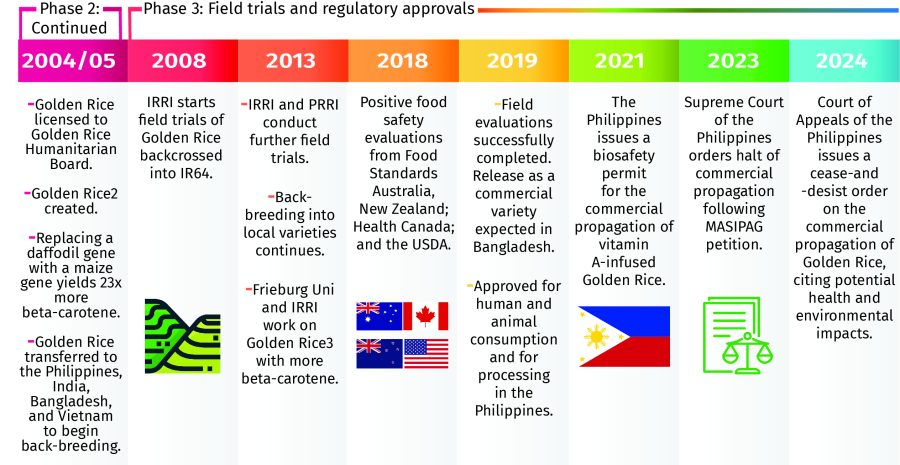Golden Rice and the Path to Sustainable Agricultural Innovation
In the Perspectives guest blog series, Farm Foundation invites participants from among the varied Farm Foundation programs to share their unique viewpoint on a topic relevant to a Farm Foundation focus area. Dr. Sandro Steinbach, the 2024 Farm Foundation Agricultural Economics Fellow, contributed this guest blog. He can be reached at sandro.steinbach@ndsu.edu. A version of this blog, co-written with Martha King, then Farm Foundation’s vice president of programs and projects, was published in October 2024 as part of the 2024 Global Agricultural Productivity (GAP) report from the GAP Initiative at Virginia Tech. It can be found on page 17 and 18 of the report.
As climate pressures and sustainability demands grow, the agricultural sector faces challenges in adopting productivity-enhancing innovations. Golden Rice, a revolutionary crop, offers valuable lessons in overcoming barriers to innovation, which is critical for a resilient and sustainable agricultural future.
Addressing the Urgent Need for Sustainable Productivity
The global population is set to reach 8.5 billion by 2030, amplifying demands on food production amidst climate change impacts. Sustainable productivity growth—measured by total factor productivity (TFP) and environmental impact—is essential to meet these needs. TFP growth depends on effective resource use and adopting new technologies that can deliver more food with less environmental impact. The Golden Rice initiative exemplifies how trade, innovation policies, and R&D can work together to foster TFP growth and meet global food security needs.
Golden Rice: A Collaborative Innovation
Rice, a staple for billions, became the focus of an ambitious global health initiative to address vitamin A deficiency in developing countries. Initiated by the Rockefeller Foundation in 1982, Golden Rice resulted from decades of international collaboration. Figure 1 illustrates its development timeline, from lab research to regulatory approval. However, the journey faced significant challenges, including regulatory hurdles and public skepticism. Golden Rice’s story underscores the importance of supportive policies for adopting innovations that can profoundly impact global nutrition and agricultural productivity.
Figure 1. Innovation and Adoption Timeline of Golden Rice


How Trade Enables Cross-Border Innovation and Development
International trade is pivotal in advancing agricultural innovation by facilitating the exchange of ideas, resources, and technology. The development of Golden Rice brought together scientists from multiple countries, including Switzerland, Germany, the United States, and the Philippines, showcasing how trade fosters collaborative breakthroughs that address global challenges. This cross-border cooperation exemplifies the value of international R&D networks in scaling agricultural technologies across diverse environments, regulatory frameworks, and public needs.
The Role of Innovation Policies in Agricultural Advancement
As illustrated in Figure 2, R&D investment in the United States initially spurred significant TFP growth, with public R&D investments driving agricultural productivity. However, recent declines in public R&D funding have coincided with slower TFP growth, highlighting the need for robust innovation policies. Supportive policies, including intellectual property protections and transparent regulatory frameworks, are essential for translating scientific discoveries into practical technologies. Golden Rice’s development benefited from these policies, yet its adoption has been slowed by regulatory barriers, particularly concerning genetically modified organisms (GMOs). This experience highlights the role of flexible, science-based regulatory frameworks that balance public safety with innovation needs.
Figure 2. Agricultural TFP Growth Stalling due to Limited Public R&D Investments

Lessons from Golden Rice on TFP Growth Potential
Golden Rice offers significant potential to boost TFP by providing enhanced nutrition without requiring additional resources. This crop addresses vitamin A deficiency and aligns with sustainable agricultural practices by reducing dependency on supplements. However, its success relies on supportive trade and innovation policies allowing global distribution. Countries like the U.S. and Canada, which have open trade policies, facilitated quicker adoption, while regions with GMO restrictions face delays. Aligning trade policies with innovation objectives can remove barriers, allowing beneficial technologies to contribute to TFP growth and broader sustainability.
Overcoming Barriers to Agricultural Innovation

Golden Rice’s journey from innovation to adoption is a case study of the challenges faced by agricultural technologies. Major obstacles include restrictive regulatory frameworks, trade barriers, and socio-economic challenges such as limited infrastructure and market access. To ensure these innovations reach farmers, streamlined and science-based regulatory approaches are essential. Figure 3 summarizes three key policy recommendations: harmonizing trade policies, developing adaptive regulatory frameworks, and fostering public-private partnerships to support innovation and adoption.
Building a Framework for Future Agricultural Innovation
The Golden Rice experience emphasizes the need for aligned global trade and policy frameworks that support sustainable productivity. As new agricultural technologies emerge to address pressing issues like climate change and food security, streamlined policies can accelerate their adoption. Policymakers must encourage R&D investments that drive TFP growth, ensuring innovations reach regions where they are needed most. Golden Rice is a valuable lesson in leveraging trade and policy to support the rapid dissemination of agricultural technology, enabling a more resilient and food-secure world.
The post Golden Rice and the Path to Sustainable Agricultural Innovation appeared first on Farm Foundation.